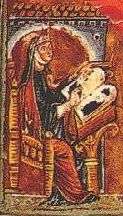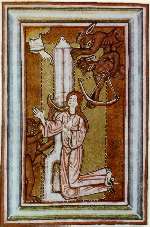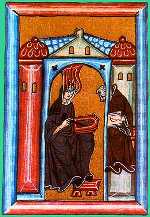Readings:
Sirach 43:1-12
Psalm 8
Colossians 3:14-17
John 3:16-21Preface of the Epiphany
[Common of a Monastic or Professed Religious]
[Common of an Arist, Writer, or Composer]
[Common of a Theologian and Teacher]
[For Artists and Writers]
[Of the Incarnation]
PRAYER (traditional language)
God of all times and seasons: Give us grace that we, after the example of thy servant Hildegard, may both know and make known the joy and jubilation of being part of thy creation, and show forth thy glory in the world; through Jesus Christ our Savior, who liveth and reigneth with thee and the Holy Ghost, one God, for ever and ever. Amen.
PRAYER (contemporary language)
God of all times and seasons: Give us grace that we, after the example of your servant Hildegard, may both know and make known the joy and jubilation of being part of your creation, and show forth your glory in the world; through Jesus Christ our Savior, who lives and reigns with you and the Holy Spirit, one God, for ever and ever. Amen.
Lessons revisd at General Convention 2024
Return to Lectionary Home Page
Webmaster: Charles Wohlers
Last updated: 21 July 2024
HILDEGARD OF BINGEN
VISIONARY (17 SEP 1179)
 "Listen: there was once a king sitting on his throne. Around him stood
great and wonderfully beautiful columns ornamented with ivory, bearing
the banners of the king with great honor. Then it pleased the king to
raise a small feather from the ground, and he commanded it to fly. The
feather flew, not because of anything in itself but because the air bore
it along. Thus am I, a feather on the breath of God."
"Listen: there was once a king sitting on his throne. Around him stood
great and wonderfully beautiful columns ornamented with ivory, bearing
the banners of the king with great honor. Then it pleased the king to
raise a small feather from the ground, and he commanded it to fly. The
feather flew, not because of anything in itself but because the air bore
it along. Thus am I, a feather on the breath of God."
Hildegard of Bingen has been called by her admirers "one of the most
important figures in the history of the Middle Ages," and "the greatest
woman of her time." Her time was the 1100's (she was born in 1098), the
century of Eleanor of Aquitaine, of Peter Abelard and Bernard of Clairvaux,
of the rise of the great universities and the building of Chartres cathedral.
She was the daughter of a knight, and when she was eight years old she
went to the Benedictine monastery at Mount St Disibode to be educated.
The monastery was in the Celtic tradition, and housed both men and women
(in separate quarters). When Hildegard was eighteen, she became a nun.
Twenty years later, she was made the head of the female community at the
monastery. Within the next four years, she had a series of visions, and
devoted the ten years from 1140 to 1150 to writing them down, describing
them (this included drawing pictures of what she had seen), and commenting
on their interpretation and significance. During this period, Pope Eugenius
III sent a commission to inquire into her work. The commission found her
teaching orthodox and her insights authentic, and reported so to the Pope,
who sent her a letter of approval. (He was probably encouraged to do so
by his friend and former teacher, Bernard of Clairvaux.) She wrote back
urging the Pope to work harder for reform of the Church. The community
of nuns at Mount St. Disibode was growing rapidly, and they did not have
adequate room. Hildegard accordingly moved her nuns to a location near
Bingen, and founded a monastery for them completely independent of the
double monastery they had left. She oversaw its construction, which included
such features (not routine in her day) as water pumped in through pipes.
The abbot they had left opposed their departure, and the resulting tensions
took a long time to heal.
Hildegard travelled throughout southern Germany and
into Switzerland and as far as Paris, preaching. Her sermons deeply moved
the hearers, and she was asked to provide written copies. In the last
year of her life, she was briefly in trouble because she provided Christian
burial for a young man who had been excommunicated. Her defense was that
he had repented on his deathbed, and received the sacraments. Her convent
was subjected to an interdict, but she protested eloquently, and the interdict
was revoked. She died on 17 September 1179. Her surviving works
include more than a hundred letters to emperors and popes, bishops, nuns,
and nobility. (Many persons of all classes wrote to her, asking for advice,
and one biographer calls her "the Dear Abby of the twelfth century.")
She wrote 72 songs including a play set to music. Musical notation had
only shortly before developed to the point where her music was recorded
in a way that we can read today. Accordingly, some of her work is now
available on compact disk, and presumably sounds the way she intended.
My former room-mate, a non-Christian and a professional musician, is an
enthusiastic admirer of her work and considers her a musical genius. Certainly
her compositional style is like nothing else we have from the twelfth
century. The play set to music is called the Ordo
Virtutum and show us a human soul who listens to the Virtues,
turns aside to follow the Devil, and finally returns to the Virtues, having
found that following the Devil does not make one happy.
She left us about seventy poems and nine books. Two
of them are books
of medical and pharmaceutical advice, dealing with the workings of
the human body and the properties of various herbs. (These books are based
on her observations and those of others, not on her visions.) I am told
that some modern researchers are now checking her statements in the hope
of finding some medicinal properties of some plant that has been overlooked
till now by modern medicine. She also wrote a commentary on the Gospels
and another on the Athanasian Creed. Much of her work has recently been
translated into English, part in series like Classics
of Western Spirituality, and part in other collections or separately.
If your university library or bookstore cannot help you, try a Christian
bookstore. If they do not have it, try a trendy (feminist, New Age, ecology)
bookstore.
 But her major works are three books on theology: Scivias
("Know the paths!"), Liber
Vitae Meritorum (on ethics), and De
Operatione Dei. They deal (or at least the first and third do)
with the material of her visions. The visions, as she describes them,
are often enigmatic but deeply moving, and many who have studied them
believe that they have learned something from the visions that is not
easily put into words. On the other hand, we have the recent best-seller,
The
Man Who Mistook His Wife for a Hat, by Oliver Sacks, Professor
of Clinical Neurology at Albert Einstein College of Medicine, and author
of Migraine
and various other books. Professor Sacks is concerned with the relation
of the brain to the mind, and ways in which the phsical state of the nervous
system can affect our ways of perceiving reality. He views the pictures
in Hildegard's books of what she saw in her visions, and says, "The style
of the pictures is a clear indication that the seer suffered regularly
from migraine attacks. Migraine sufferers tend to see things in this manner."
And indeed, it is true that Hildegard suffered throughout her life from
painful attacks of what may have been migraine. Professor Sacks hastens
to add that this has nothing to do with whether her visions are authentic
insights into the nature of God and His relation to the Universe.
But her major works are three books on theology: Scivias
("Know the paths!"), Liber
Vitae Meritorum (on ethics), and De
Operatione Dei. They deal (or at least the first and third do)
with the material of her visions. The visions, as she describes them,
are often enigmatic but deeply moving, and many who have studied them
believe that they have learned something from the visions that is not
easily put into words. On the other hand, we have the recent best-seller,
The
Man Who Mistook His Wife for a Hat, by Oliver Sacks, Professor
of Clinical Neurology at Albert Einstein College of Medicine, and author
of Migraine
and various other books. Professor Sacks is concerned with the relation
of the brain to the mind, and ways in which the phsical state of the nervous
system can affect our ways of perceiving reality. He views the pictures
in Hildegard's books of what she saw in her visions, and says, "The style
of the pictures is a clear indication that the seer suffered regularly
from migraine attacks. Migraine sufferers tend to see things in this manner."
And indeed, it is true that Hildegard suffered throughout her life from
painful attacks of what may have been migraine. Professor Sacks hastens
to add that this has nothing to do with whether her visions are authentic
insights into the nature of God and His relation to the Universe.
 Hildegard
has undergone a remarkable rise in popularity in the last thirty years,
since many readers have found in her visions, or read into them, themes
that seem to speak to many modern concerns. For example:
Hildegard
has undergone a remarkable rise in popularity in the last thirty years,
since many readers have found in her visions, or read into them, themes
that seem to speak to many modern concerns. For example:
Although she would have rejected much of the rhetoric
of women's liberation, she never hesitated to say what she thought needed
to be said, or to do what she thought needed to be done, simply because
she was a woman. When Pope or Emperor needed a rebuke, she rebuked them.
Her writings bring science, art, and religion together.
She is deeply involved in all three, and looks to each for insights that
will enrich her understanding of the others.
Her use of parable and metaphor, of symbols, visual
imagery, and non-verbal means to communicate makes her work reach out
to many who are totally deaf to more standard approaches. In particular,
non-Western peoples are often accustomed to expressing their views of
the world in visionary language, and find that Hildegard's use of similar
language to express a Christian view of reality produces instant rapport,
if not necessarily instant agreement.
Hildegard wrote and spoke extensively about social
justice, about freeing the downtrodden, about the duty of seeing to it
that every human being, made in the image of God, has the opportunity
to develop and use the talents that God has given him, and to realize
his God-given potential. This strikes a chord today.
Hildegard wrote explicitly about the natural world
as God's creation, charged through and through with His beauty and His
energy; entrusted to our care, to be used by us for our benefit, but not
to be mangled or destroyed.
by James Kiefer
Much of her work is musical, and has been recorded by many, notably by the group Sequentia.